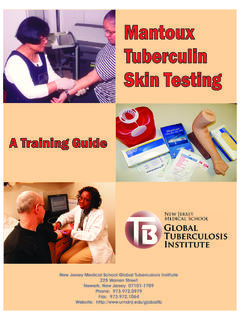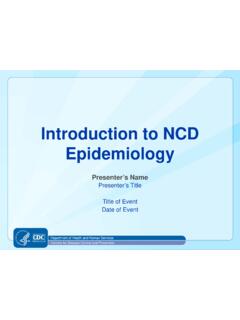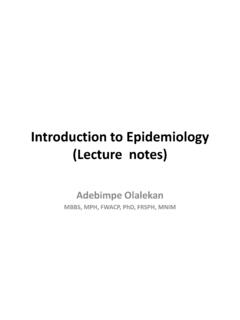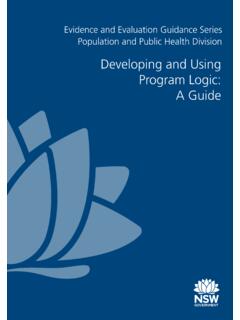Transcription of EPIDEMIOLOGY FACT SHEET 1: Primary, Secondary, and ...
1 EPIDEMIOLOGY FACT SHEET 1: Primary, Secondary, and Tertiary Prevention Fact SHEET - TB Examples STUDENTS OR INSTRUCTORS July 23, 2009 1 EPI Fact SHEET 1: Primary, Secondary, and Tertiary Prevention Fact SHEET TB Examples LEARNING OBJECTIVES After reviewing this Fact SHEET , participants should be able to: Distinguish among primary, secondary, and tertiary prevention activities Provide examples of primary, secondary, and tertiary prevention activities related to the prevention and control of M. tuberculosis ASPH DISCIPLINE-SPECIFIC COMPETENCIES ADDRESSED IN THIS FACT SHEET Apply the basic terminology and definitions of EPIDEMIOLOGY Communicate epidemiologic information to lay and professional audiences ASPH INTERDISCIPLINARY/CROSS-CUTTING COMPETENCIES ADDRESSED IN THIS FACT SHEET [Public Health Biology] Apply biological principles to development and implementation of disease prevention, control, or management programs [Systems Thinking] Identify characteristics of a system This material was developed by the staff at the Global Tuberculosis Institute (GTBI), one of four Regional Training and Medical Consultation Centers funded by the Centers for Disease Control and Prevention.
2 It is published for learning purposes only. Permission to reprint excerpts from other sources was granted. Case study author(s) name and position: George Khalil, MPH (work done as MPH candidate) Marian R. Passannante, PhD Associate Professor, University of Medicine & Dentistry of New Jersey, New Jersey Medical School and School of Public Health Epidemiologist, NJMS, GTBI For further information please contact: New Jersey Medical School Global Tuberculosis Institute (GTBI) 225 Warren Street Box 1709 Newark, NJ 07101-1709 or by phone at 973-972-9008 EPIDEMIOLOGY FACT SHEET 1: Primary, Secondary, and Tertiary Prevention Fact SHEET - TB Examples STUDENTS OR INSTRUCTORS July 23, 2009 2 introduction EPIDEMIOLOGY is an important part of tuberculosis (TB) control efforts because the information on patterns of infection and disease can assist in identifying people or groups of people at risk for TB, understanding how the disease is transmitted, prioritizing cases, and planning appropriate use of staff and The objectives of EPIDEMIOLOGY are to.
3 Identify the cause of disease or risk for disease Determine the burden of disease in a community Study the natural history and prognosis of disease Evaluate both existing and new preventive and therapeutic measures and modes of health care delivery Provide the foundation for developing public policy and regulatory decisions relating to environmental problems2 In a community or group with a high burden of disease, it is the responsibility of public health officials, knowing its cause and biologic implications, to put in place preventive measures to alleviate the burden. There are three prevention approaches that are crucial in decreasing mortality and morbidity of a disease: primary, secondary, and tertiary prevention. These levels of prevention were first described by Leavell and Clark3 and continue to provide a useful framework to describe the spectrum of prevention activities.
4 Primary Prevention Primary prevention denotes action taken to prevent the development of a disease in a person who is well and does not have the disease in question (page 6).2 These activities include health promotion as well as disease prevention activities. Health promotion activities can be as simple as using appropriate hand washing techniques or can be more sophisticated such as vaccination to prevent disease occurrence. 1. Vaccines The only vaccination for TB on the market is the bacille Calmette-Gu rin (BCG) vaccine; however, its use is rarely indicated in the United States. Before putting a vaccine on the market in the United States, the Centers for Disease Control and Prevention (CDC) along with the US Food and Drug Administration and other government agencies, must evaluate the vaccines efficacy, safety, contraindications, utility, and cost effectiveness.
5 Two controlled prospective community trials before 1955 and studies done in 1947, 1950, and after 1975 using different BCG strains, found poor efficacy ranging from 0% to 80%.4,5 In addition to poor efficacy, the BCG vaccine is not indicated in the United States because secondary prevention techniques are greatly hindered by the BCG vaccine, which can interfere with the management of persons who are possibly infected with M. tuberculosis. EPIDEMIOLOGY FACT SHEET 1: Primary, Secondary, and Tertiary Prevention Fact SHEET - TB Examples STUDENTS OR INSTRUCTORS July 23, 2009 3 Safety is another concern when evaluating a vaccine. High rates of local reaction and infection often leave a permanent scar at the site of a BCG vaccine. Also, the estimated risk of a complication from a subcutaneous abscess is 387 per 1 million vaccinations, per 1 million from a musculoskeletal lesion, and per 1 million fatalities from disseminated Since the resurgence of TB in the early 1990s, the BCG vaccine was again evaluated for use in the United States.
6 Since then, the CDC has made the following recommendations6 : 1) BCG is considered for children in the United States who have a negative tuberculin skin test (TST) and are continually exposed to an untreated or ineffectively treated patient who has infectious TB and/or drug-resistant TB and cannot be isolated from the patient; 2) BCG is also considered on a case-by-case basis for health care workers in high-risk settings. Currently, new vaccines for the prevention of TB are in the development 2. Environmental controls Another form of primary prevention for TB is environmental control, such as ultraviolet lights and ventilation; however, these measures are taken mostly at hospitals and cannot be practically implemented at places where most TB transmission exists ( , nursing homes, prisons, in the community, etc.).8 However, programs aimed at decreasing overcrowding can also be considered primary prevention measures for TB.
7 Secondary Prevention Secondary prevention denotes the identification of people who have already developed a disease, at an early stage in the disease s natural history, through screening and early intervention. The rationale for secondary prevention is that if we can identify disease earlier in its natural history, intervention measures will be more effective. Perhaps we can prevent mortality or complications of the disease and use less invasive or less costly treatment to do so .2 (page 6) 1. Detection of latent TB infection (LTBI) The CDC recommends a strategy to identify those who have LTBI and, if indicated, the use of chemotherapy to prevent the latent infection from progressing to active TB disease. There are two tests that can be used to help detect LTBI. a. The Tuberculin Skin Test (TST) The first is a skin test in which testing material, called tuberculin, is injected intradermally into the individual and in 2 to 3 days, the patient returns to the health care worker who checks to see if there is a reaction to the b.
8 QuantiFERON-TB Gold (QFT-G) The second test used to identify LTBI is QFT-G, a blood test that measures how a person s system reacts to the bacteria that causes EPIDEMIOLOGY FACT SHEET 1: Primary, Secondary, and Tertiary Prevention Fact SHEET - TB Examples STUDENTS OR INSTRUCTORS July 23, 2009 4As mentioned previously, secondary control methods for TB are greatly hindered by the BCG vaccine. Post-vaccination BCG-induced tuberculin reactivity ranges from no induration to an induration of 19 mm at the skin-test site. Tuberculin reactivity caused by BCG vaccination wanes with time and is unlikely to persist >10 years after vaccination in the absence of M. tuberculosis exposure and infection. Recent studies have suggested that the QFT-G is more sensitive than the Another recent study that compared TST and QFT-G found that the QFT-G test was highly specific and unaffected by BCG vaccination status, a major cause of false-positive TST Since there is no gold standard for screening tests to determine if someone has TB disease, other specialized tests such as chest X-ray and a sample of sputum may be needed.
9 Table I is a summary of evidence comparing TST to QFT-G, a type of interferon-gamma assay. Advances in the diagnosis and treatment of tuberculosis. Nahid P, Pai M, Hopewell PC. Am Thorac Soc. 2006;3:103-110. (permission pending) Secondary prevention of TB involves the identification and testing of targets groups of people and communities with greater likelihood of being infected. "Targeted tuberculin testing for LTBI is a strategic component of tuberculosis (TB) control that identifies persons at high risk for developing TB who would benefit by treatment of LTBI, if detected .8 Some of these high risk groups are: Health care workers who work with patients at risk of TB Those who have lived or traveled extensively in areas where TB is endemic Immunocompromised individuals Those who have had a recent positive conversion of a skin test Persons who live in a congregant setting ( jails and nursing homes) Homeless persons EPIDEMIOLOGY FACT SHEET 1: Primary, Secondary, and Tertiary Prevention Fact SHEET - TB Examples STUDENTS OR INSTRUCTORS July 23, 2009 5 Another type of secondary prevention measure is called a contact investigation.
10 During a contact investigation a public health worker interviews patients with active TB disease in order to identify contacts or people who may have been exposed to that person. Once identified the contacts will be evaluated for LTBI and TB disease and provided with appropriate treatment, when necessary. 2. Treatment of LTBI Patients who are identified as being infected with TB should be evaluated for active TB disease, by receiving a chest X-ray, and a focused clinical evaluation. Once active disease is excluded, one of the following treatments listed in Table 2 is indicated. Table: Drug Regimens for the Treatment of LTBI Drugs Duration (months) Interval Minimum doses Isoniazid 9 Daily 270 Twice weekly* 76 Isoniazid 6 Daily 180 Twice weekly* 52 Rifampin 4 Daily 120 * Directly observed therapy (DOT) is mandatory for patients on twice weekly (intermittent) therapy Table source: modified version of CDC table available at: Accessed March 19, 2008.










